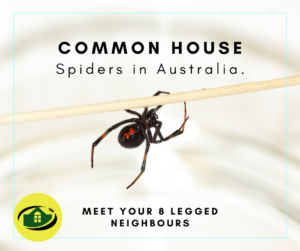Common House Spiders in Australia.
Australia is home to a diverse range of wildlife, and that includes spiders. While the mere mention of these eight-legged creatures may send shivers down some spines, most spiders found in Australian homes are harmless and even beneficial. In this blog post, we’ll introduce you to some of the main species of spiders commonly found in households across the country. By understanding these arachnids better, you can coexist with them peacefully and appreciate their role in controlling other pests.
1. Huntsman Spider (Sparassidae):
- Appearance: Large, flattened bodies, long legs, brown or grey coloration.
- Habitat: Often found on walls, ceilings, or hiding in corners.
- Behavior: Huntsman spiders are excellent hunters and are known for their speed and agility. They are non-venomous and primarily prey on insects.
2. Daddy Long-Legs Spider (Pholcidae):
- Appearance: Small bodies with extremely long, thin legs, pale gray or brown color.
- Habitat: Typically found in dark and damp areas, such as basements and bathrooms.
- Behavior: Daddy long-legs spiders are harmless to humans and are known for their tangled webs, where they catch and feed on other smaller insects.
3. Garden Orb-Weaving Spider (Araneidae):
- Appearance: Medium-sized, round bodies, colorful abdomens with intricate patterns.
- Habitat: Outdoor gardens, often building large orb-shaped webs.
- Behavior: These spiders are excellent at catching flying insects in their webs and are beneficial for controlling garden pests.
4. Redback Spider (Latrodectus hasseltii):
- Appearance: Small to medium-sized with a distinct red stripe on their abdomen.
- Habitat: Often found in sheltered outdoor areas, garages, and sheds.
- Behavior: Redback spiders are venomous, and while their bites can be painful, they are rarely life-threatening. They prefer dark, quiet spaces and are known to build messy webs.
5. White-Tailed Spider (Lampona spp.):
- Appearance: Medium-sized spiders with a white-tipped abdomen and dark body.
- Habitat: Found indoors and outdoors in dark, hidden places.
- Behavior: White-tailed spiders are not considered dangerous to humans, though they can deliver painful bites. They primarily feed on other spiders.
6. Cellar Spider (Pholcidae):
- Appearance: Small, fragile bodies with long, delicate legs.
- Habitat: Dark and damp areas like cellars, basements, and under eaves.
- Behavior: Cellar spiders are excellent hunters of other pests and are often seen hanging upside down in their irregular webs.
7. Common House Spider (Achaearanea tepidariorum):
- Appearance: Small to medium-sized, brownish with a chevron-shaped pattern on the abdomen.
- Habitat: Found indoors in warm and dry places.
- Behavior: Common house spiders build cobweb-like webs and are harmless to humans, primarily preying on flies and other small insects.
8. St. Andrew’s Cross Spider (Argiope keyserlingi):
- Appearance: Large, colorful spiders with a distinctive cross-shaped web.
- Habitat: Gardens and outdoor spaces, where they build large, ornate webs.
- Behavior: These spiders are not dangerous to humans and are known for their beautiful and intricate web designs.
If you have concerns in your home with Spiders, then get in touch with us here at Senior Pest Management to arrange a thorough inspection of your home today.






